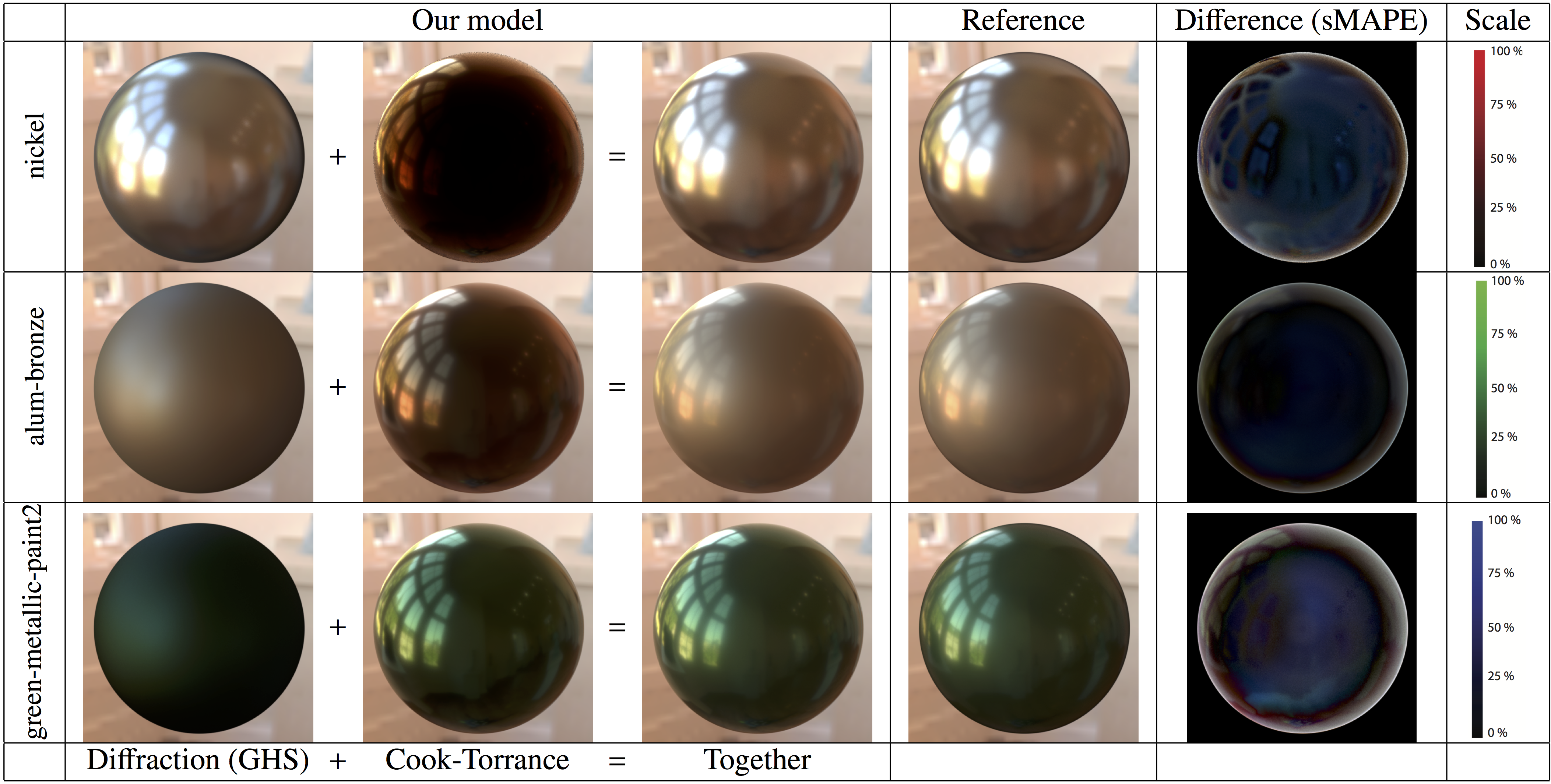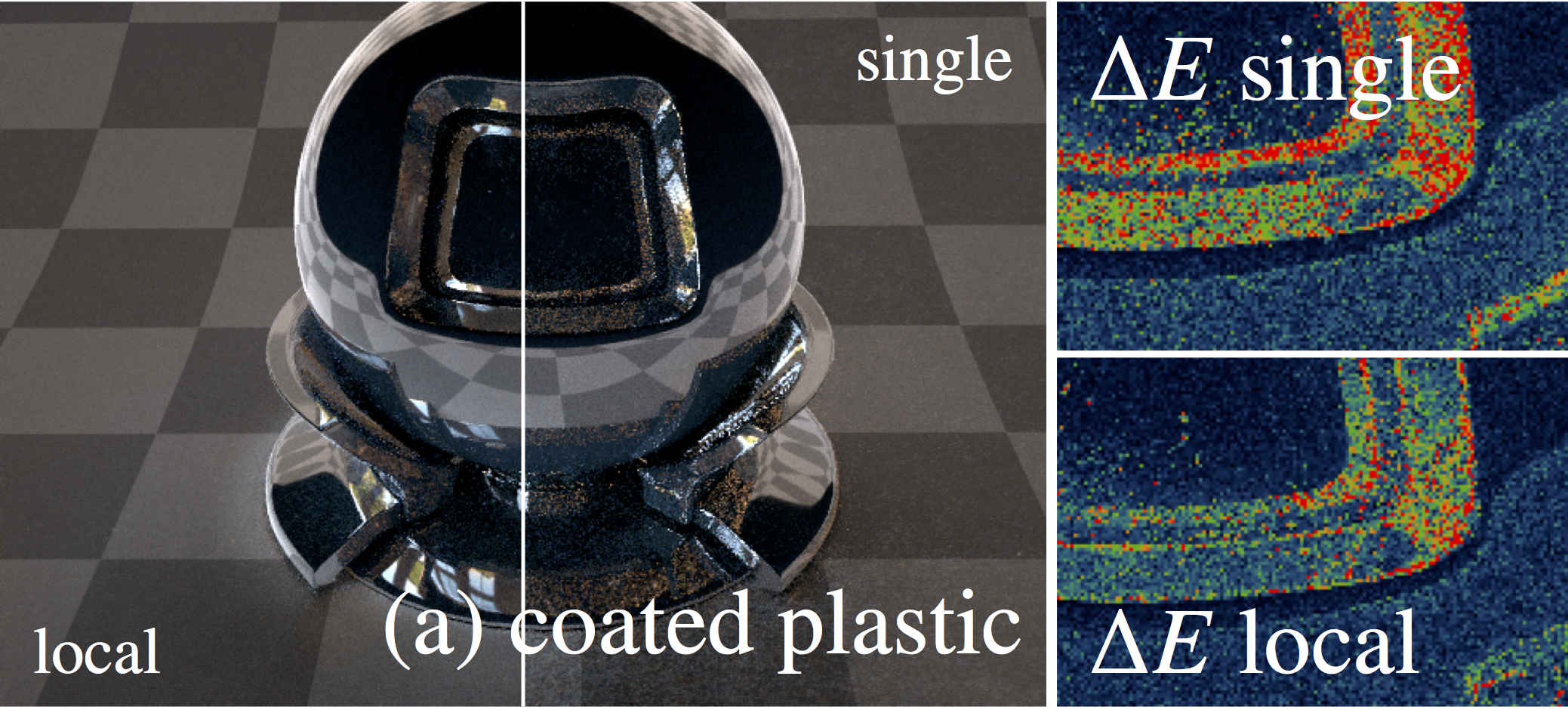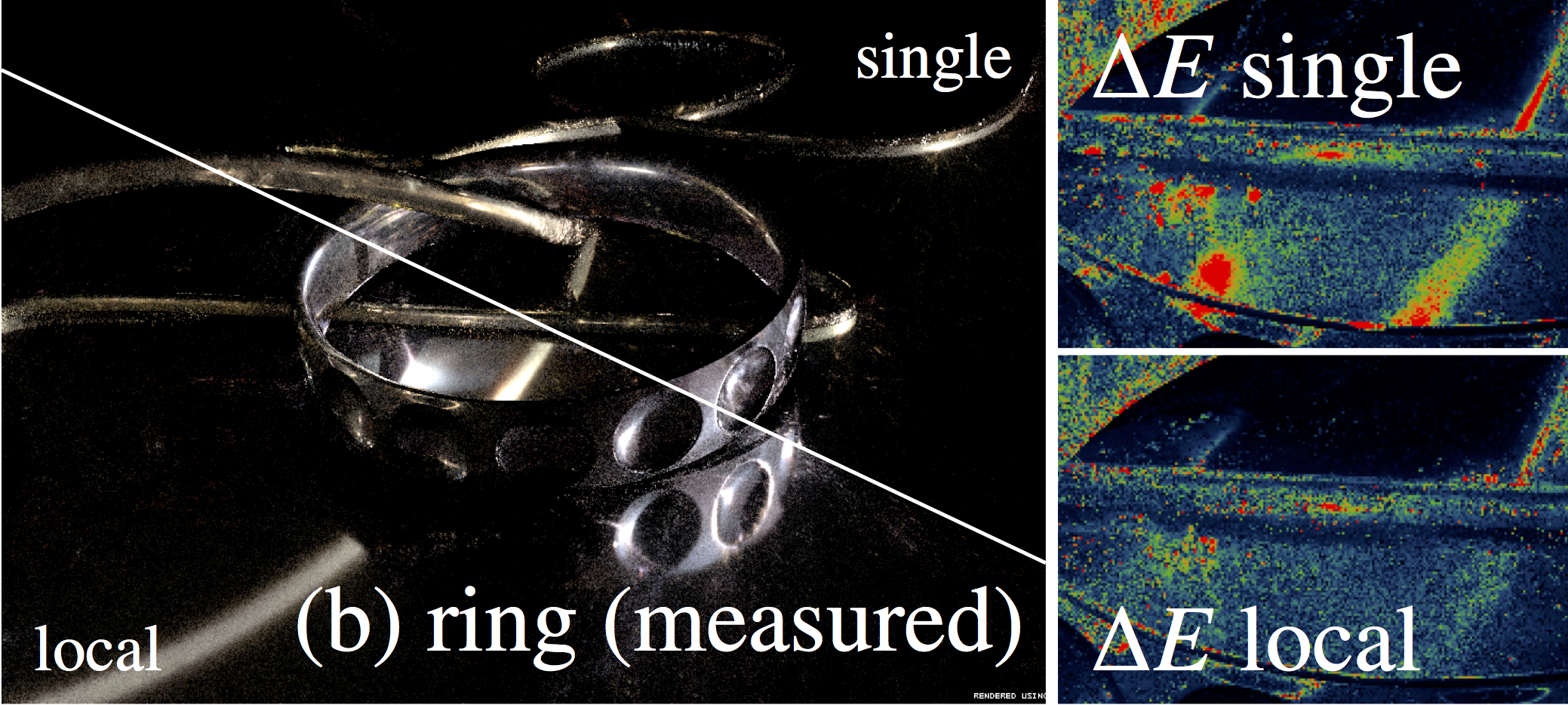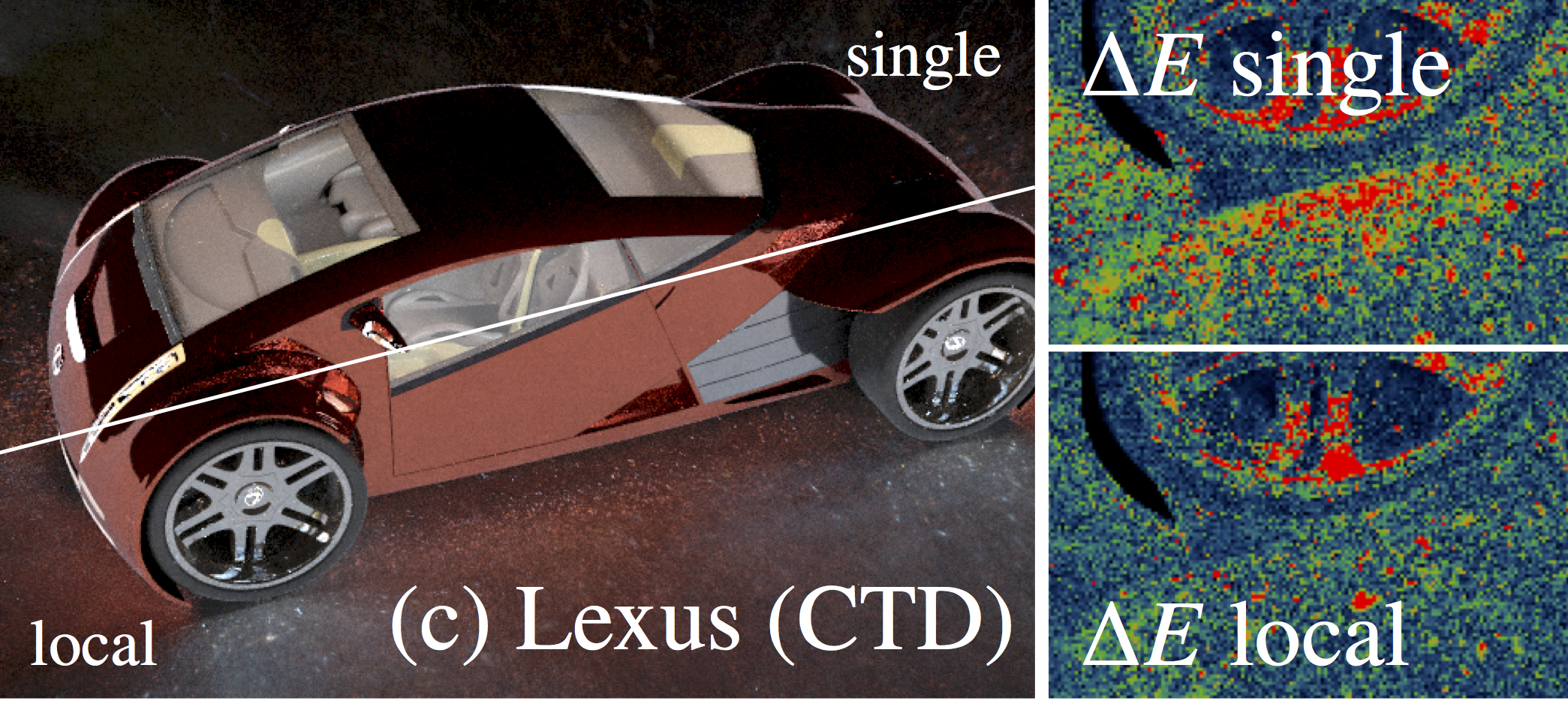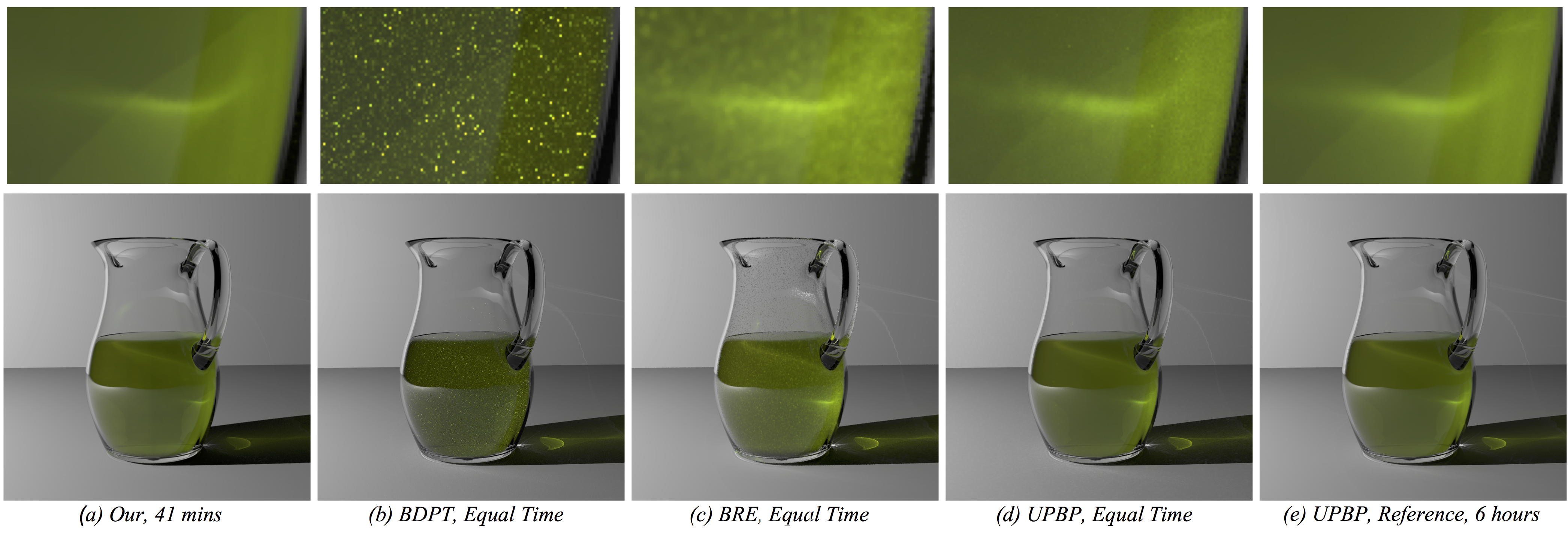Section: New Results
Illumination Simulation and Materials
A Physically-Based Reflectance Model Combining Reflection and Diffraction
Participant : Nicolas Holzschuch.
Reflectance properties express how objects in a virtual scene interact with light; they control the appearance of the object: whether it looks shiny or not, whether it has a metallic or plastic appearance. Having a good reflectance model is essential for the production of photo-realistic pictures. Measured reflectance functions provide high realism at the expense of memory cost. Parametric models are compact, but finding the right parameters to approximate measured reflectance can be difficult. Most parametric models use a model of the surface micro-geometry to predict the reflectance at the macroscopic level. We have shown that this micro-geometry causes two different physical phenomena: reflection and diffraction. Their relative importance is connected to the surface roughness. Taking both phenomena into account, we developped a new reflectance model that is compact, based on physical properties and provides a good approximation of measured reflectance (See Figure 7).
|
A Robust and Flexible Real-Time Sparkle Effect
Participant : Beibei Wang.
We present a fast and practical procedural sparkle effect for snow and other sparkly surfaces which we integrated into a recent video game. Following from previous work, we generate the sparkle glints by intersecting a jittered 3D grid of sparkle seed points with the rendered surface. By their very nature, the sparkle effect consists of high frequencies which must be dealt with carefully to ensure an anti-aliased and noise free result (See Figure 8). We identify a number of sources of aliasing and provide effective techniques to construct a signal that has an appropriate frequency content ready for sampling at pixels at both foreground and background ranges of the scene. This enables artists to push down the sparkle size to the order of 1 pixel and achieve a solid result free from noisy flickering or other aliasing problems, with only a few intuitive tweakable inputs to manage [9].
Capturing Spatially Varying Anisotropic Reflectance Parameters using Fourier Analysis
Participants : Nicolas Holzschuch, Alban Fichet.
Reflectance parameters condition the appearance of objects in photorealistic rendering. Practical acquisition of reflectance parameters is still a difficult problem. Even more so for spatially varying or anisotropic materials, which increase the number of samples required. We present an algorithm for acquisition of spatially varying anisotropic materials, sampling only a small number of directions. Our algorithm uses Fourier analysis to extract the material parameters from a sub-sampled signal. We are able to extract diffuse and specular reflectance, direction of anisotropy, surface normal and reflectance parameters from as little as 20 sample directions (See Figure 9). Our system makes no assumption about the stationarity or regularity of the materials, and can recover anisotropic effects at the pixel level. This work has been published at Graphics Interface 2016 [6].
|
Estimating Local Beckmann Roughness for Complex BSDFs
Participant : Nicolas Holzschuch.
Many light transport related techniques require an analysis of the blur width of light scattering at a path vertex, for instance a Beckmann roughness. Such use cases are for instance analysis of expected variance (and potential biased countermeasures in production rendering), radiance caching or directionally dependent virtual point light sources, or determination of step sizes in the path space Metropolis light transport framework: recent advanced mutation strategies for Metropolis Light Transport, such as Manifold Exploration and Half Vector Space Light Transport employ local curvature of the BSDFs (such as an average Beckmann roughness) at all interactions along the path in order to determine an optimal mutation step size. A single average Beckmann roughness, however, can be a bad fit for complex measured materials and, moreover, such curvature is completely undefined for layered materials as it depends on the active scattering layer. We propose a robust estimation of local curvature for BSDFs of any complexity by using local Beckmann approximations, taking into account additional factors such as both incident and outgoing direction (See Figure 10). This work has been published as a Siggraph 2016 Talk [18].
|
MIC based PBGI
Participant : Beibei Wang.
Point-Based Global Illumination (PBGI) is a popular rendering method in special effects and motion picture productions. The tree-cut computation is in gen eral the most time consuming part of this algorithm, but it can be formulated for efficient parallel execution, in particular regarding wide-SIMD hardware. In this context, we propose several vectorization schemes, namely single, packet and hybrid, to maximize the utilization of modern CPU architectures. Whil e for the single scheme, 16 nodes from the hierarchy are processed for a single receiver in parallel, the packet scheme handles one node for 16 receivers. These two schemes work well for scenes having smooth geometry and diffuse material. When the scene contains high frequency bumps maps and glossy reflection s, we use a hybrid vectorization method. We conduct experiments on an Intel Many Integrated Core architecture and report preliminary results on several sce nes, showing that up to a 3x speedup can be achieved when compared with non-vectorized execution [19].
Point-Based Light Transport for Participating Media with Refractive Boundaries
Participants : Beibei Wang, Jean-Dominique Gascuel, Nicolas Holzschuch.
Illumination effects in translucent materials are a combination of several physical phenomena: absorption and scattering inside the material, refraction at its surface. Because refraction can focus light deep inside the material, where it will be scattered, practical illumination simulation inside translucent materials is difficult. In this paper, we present an a Point-Based Global Illumination method for light transport on translucent materials with refractive boundaries. We start by placing volume light samples inside the translucent material and organising them into a spatial hierarchy. At rendering, we gather light from these samples for each camera ray. We compute separately the samples contributions to single, double and multiple scattering, and add them (See Figure 11). Our approach provides high-quality results, comparable to the state of the art, with significant speed-ups (from 9 to 60 depending on scene c omplexity) and a much smaller memory footprint [10], [12].
|



